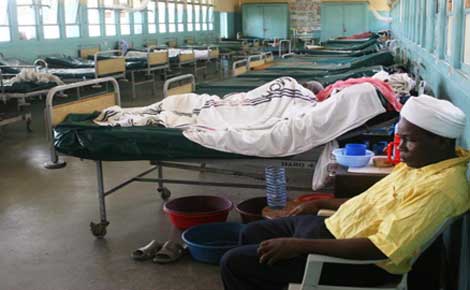 Daniel Munga Mburu takes care of his ailing father Paul Mburu at the Coast General Hospital ward six
Daniel Munga Mburu takes care of his ailing father Paul Mburu at the Coast General Hospital ward six
Elgeyo Marakwet Governor Alex Tolgos last month visited a health centre in his county to find no staff at the facility supposed to operate on a 24-hour basis.
Tolgos, whose county has the second highest absenteeism rate in the country, had visited Kaptalamwa Health Centre in Marakwet East and found it deserted.
Absenteeism is a major factor in many counties’ inability to provide health services. Other factors include poor infrastructure and unavailability of drugs.
Missing workers are making the problems in the health sector, already burdened by a serious staff shortage, more worse.
Nyeri, Elgeyo Marakwet and Kisii counties have the worst rates of absenteeism among health staff in the country, with more than a third of their staff skipping duty, a new report has shown.
A Ministry of Health survey ranked Lamu, Nandi and West Pokot as the best three counties in terms of health staff availability, with a near 100 per cent turnout at the time of the survey.
Rounding up the top five were Laikipia and Wajir counties, both of which had only 3 per cent of their staff absent at the time of the survey.
Some 42 per cent of health workers in Nyeri County were absent from their work stations, the worst showing in the country.
However, Dr Charles Githinji, the Nyeri County Executive for Health, says he was not aware of the survey and also doubted the veracity of the report.
“Nobody has mentioned such a survey. I cannot comment on something I have not seen or been aware of,” says Githinji.
Elgeyo Marakwet and Kisii had 40 per cent and 37 per cent of their health staff missing from duty, respectively, while the rates were 34 per cent in Kericho and 33 per cent in Kajiado.
The study, Government of Kenya, 2014: Kenya Service Availability and Readiness Assessment Mapping (SARAM) puts the national absenteeism rate at 15 per cent. This means that at least one in every six employees was unavailable during the survey despite the serious staff shortage of health personnel across the country.
The survey was funded by the World Health Organisation (WHO) and the British government. It was conducted last year and released in August, this year. It does not say exactly when inspectors visited each county.
Although Kajiado Governor David Nkedianye says he cannot comment directly on the survey because he has not seen it, he admits that the county has faced the challenge of absenteeism among health workers.
“My health minister and a team are working to address the problem. I have instructed them to step up supervision of doctors and other health workers in the health centres around the county. Our main challenge has been the vastness of the terrain,” he told The Standard on Sunday.
Training is the single biggest reason why most workers were not at their stations, accounting for about 68 per cent of absent personnel. Another 21 per cent were away for various unlisted reasons.
Though most trainings are approved and are necessary for staff development, many take a year or two to complete. Thus, workers end up spending most of their hours in class instead of running health facilities for that duration.
About four per cent of the staff who were absent had taken maternity or sick leave, while another three per cent were on some official mission. Some employees were said to have gone to retrieve their salaries. The rest were just not on shift or had left without permission.
The highest number of staff reported for any form of absence was in Mombasa (1,253), followed by Kiambu (628), Nakuru (557) and Machakos (521).
The SARAM report is the first national census that comprehensively maps health services across the country to assess the capacity for service provision, sector investments and readiness to provide services by county.
Its findings are corroborated by the latest Service Delivery Indicators (SDI) report card, which revealed worrying absenteeism in health work force.
According to the 2013 SDI health report card, more than 29 per cent of public health providers were absent at their work stations at the time of a survey, with the highest absence rate in large urban health centres.
The World Bank-funded report found that 80 per cent of this absence was approved.
Ironically, the absence is not just limited to the public sector, given that 21 per cent of the health personnel in the private sector were also absent from their stations at the time of the survey.
Further, the absence rates in urban areas were more severe, 38 per cent, than rural areas, 28 per cent.
The SDI provides a set of metrics to benchmark the performance of clinics in Africa, given that nurses and doctors are an invaluable resource in determining the quality of health services.
Since the health sector was devolved last year, county governments have been struggling to have better control of their personnel.
The problem of absenteeism is compounded by the existence of hundreds of ghost workers in the public service. For instance, audits revealed 134 ghost workers in Elgeyo Marakwet and 70 ghost doctors in Uasin Gishu, who had been receiving salaries from the Government.
It is hoped that more of the ghost workers will be unearthed after the ongoing national biometric registration of civil servants is completed.
But impromptu visits by county administrators remain the best way of monitoring staff in the counties.
Machakos Governor Alfred Mutua is known for his impromptu visits to hospitals in his county, and which are later publicised on social media, in a bid to “to check on services given to patients and the general state of the facility”.
It is an open secret in medical circles that many doctors make their morning rounds and then retire to their private clinics, leaving the rest of the day’s work to nurses.
According to Daniel Yumbya, the chief executive of the Medical Practitioners and Dentists Board (MPDB), the agency that licenses doctors, unless doctors are fully registered, they can easily be off the radar, absent but still on pay.
“Recently, there was the case of a doctor who went for training abroad for two years, but we only learned this when they returned,” says Yumbya, whose agency has in the recent months been cracking down on errant doctors said.
The MPDB is currently compiling a national register that will include all the registered doctors and their stations by county.
At the Kenyatta National Hospital (KNH), Kenya’s national referral hospital, it is common practice for a registrar, a medical officer studying to be a specialist, to take on extra shifts for his superiors, or supervisors, earning about Sh800 an hour.
Absent Doctors series tomorrow in your Standard:
We will probe the distribution of health workers across the country. For example, there is at least one health worker for 197 people in Embu County, one member of staff for every 227 people in Mombasa County, and a population of 238 people for every one health sector employee in Nyeri County. The results paint a rather gloomy picture and amplify the challenges confronting the health system.
 The Standard Group Plc is a multi-media organization with investments in media platforms spanning newspaper print
operations, television, radio broadcasting, digital and online services. The Standard Group is recognized as a
leading multi-media house in Kenya with a key influence in matters of national and international interest.
The Standard Group Plc is a multi-media organization with investments in media platforms spanning newspaper print
operations, television, radio broadcasting, digital and online services. The Standard Group is recognized as a
leading multi-media house in Kenya with a key influence in matters of national and international interest.











